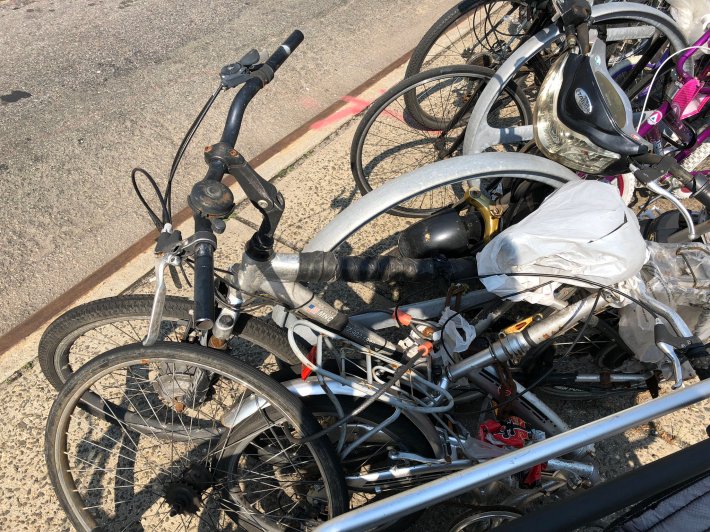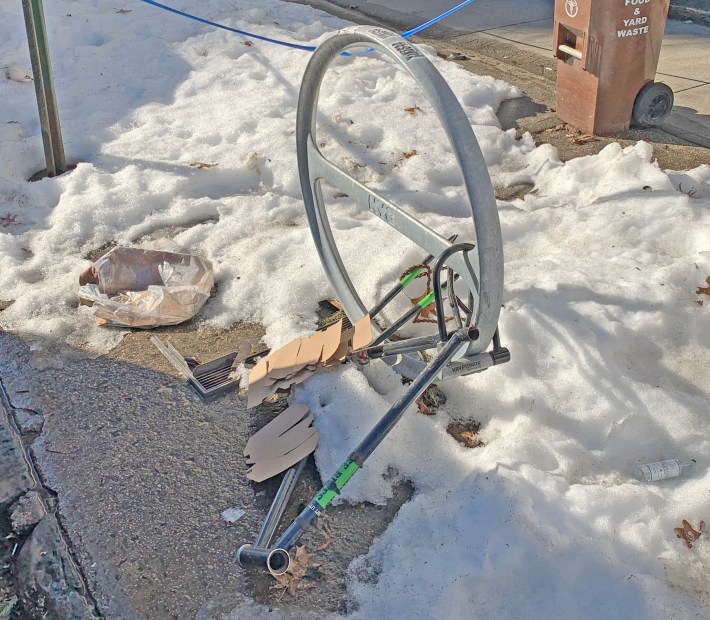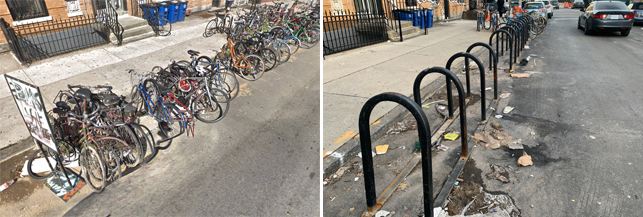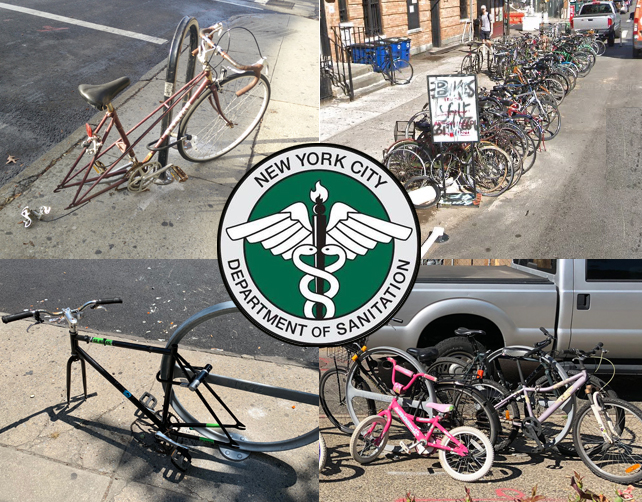The Department of Sanitation does not remove the vast majority of reported abandoned bikes from city streets, where they continue to consume available bike parking — but the problem stems from badly written rules, a flawed system of accepting complaints and the public's own misunderstanding of just what a derelict bike actually is.
The good news? The confusion and failure may — operative word there, may — pave the way for major reform later in the year.
Streetsblog conducted an exhaustive review of 9,055 abandoned bike complaints to 311 between Aug. 1, 2016 and Jan. 15, 2021, and found that very few "derelict" bikes are ever removed after a public report:
- 6,048 (or 66.8 percent) of the reports ended with the Sanitation Department taking no action to remove the bike.
- 1,218 (or 13.4 percent) of the reports ended with DSNY removing the derelict bike.
- And the agency's success at removing reported derelict bikes varies greatly by borough — calls of derelict bikes in Brooklyn and Manhattan led to a bike being removed 25 percent of the time, but only 7 percent of the time in Queens and 10 percent in The Bronx.
Let's first break down all the 9,055 complaints to 311:
No action taken
Of the 6,048 reported abandoned bikes that were not removed:
- 3,957 were logged as, "The Department of Sanitation investigated and found that the bike does not meet the criteria to be classified as derelict." (Remember that classification — there'll be a quiz later.)
- 2,022 were logged as, "The Department of Sanitation investigated this complaint and found no condition at the location."
- 69 were logged in 311 as, "The Department of Sanitation investigated this complaint and found no violation at the location."
Action taken
Of the 1,218 bikes reported to 311 that were removed:
- 16 were logged as, "The Department of Sanitation cleaned the location."
- 1,198 were logged as, "The Department of Sanitation removed the items."
- 4 were logged as, "The Department of Sanitation picked up the items and determined that the missed collection complaint was not warranted." (The words in italics suggest that perhaps these four "items" might have been erroneously logged as removed bikes — but it's only four reports, which is not enough to skew the findings.)
It's important to note that the DSNY also removes derelict bikes that have not been reported to 311. Agency spokesman Joshua Goodman said another 1,014 bikes had been removed by DSNY since 2016.
The rest
A sizable portion of 311 reports — 1,798 of them, or roughly 20 percent of all 311 reports about derelict bikes — result in these seemingly abandoned bikes remaining in limbo, where they likely continue to crowd bike racks or sign poles or other places people park bikes in a city with far too little bike parking:
- 15 were logged as "The Department of Sanitation is in the process of investigating this complaint." (But none had a follow up log report, meaning the bike was likely not removed.)
- 64 were logged as, "The Department of Sanitation found an open service request already exists for the same location." (All that means is that some bikes needed multiple 311 calls to get addressed, which is hardly a solid measure of success. Worse, 25 of these reports — nearly 40 percent — were fabrications; there was no prior report of an abandoned bike.
- 7 were logged as, "The Department of Sanitation found the vehicle to be abandoned and derelict and tagged it for removal by their contactor [sic], which should occur within 72 hours." (It is unclear if any of those bikes were eventually removed.)
- 4 were logged as, "The Department of Sanitation investigated this complaint and issued a Notice of Violation." (It is unclear if those bikes were also removed.)
- 15 were related to requests involving a Citi Bike. In those cases, 311 users are told, "This is a NYC Department of Transpiration  [sic] Bike-Share location. Please report conditions at this location to NYC DOT via 3-1-1." (It is unclear if those bikes were removed.)
- 40 reporters were logged as, "The Bicycle was found to be affixed to private property and therefore not eligible for removal by the City."
- 24 were logged as, "The Department of Sanitation picked up the appliance and determined that the missed collection complaint was not warranted because the item was not tagged to indicated that the CFC had been removed." (CFC means "chlorofluorocarbon," so it is clear that whomever responded to the scene likely did not remove a bike, but since the log book says "picked up the appliance," we cannot be sure.)
- 1 was logged as, "The Department of Sanitation investigated this complaint and salted the area."
- 763 were logged as, "The owner claimed the bicycle was not abandoned." (This could mean that the owner removed the bike ... or simply removed the warning that the DSNY had placed on it. In either case, the bike was not removed by DSNY.)
- 855 were logged as, "The Department of Sanitation has investigated the complaint and addressed the issue. If the problem persists, call 311 to enter a new complaint."
That last one is particularly difficult to understand because it is unclear what "addressing" the issue means, but it almost certainly does not mean that the DSNY removed the bike. According to DSNY spokesman Joshua Goodman, that log entry suggests that either "the owner removed the bike" or "it was deemed not-derelict." But in both cases, the public "should fee free" to call 311 again if the bike "later comes back" or if it "later becomes derelict."
Activists aren’t satisfied.
“The current regulations clearly aren't working,” said Cory Epstein of Transportation Alternatives. “We welcome reforms to this process and believe this issue only reinforces the need for high-quality, secure bike parking across New York City."
Finally, a borough-by-borough breakdown (with map!)
- Manhattan
- Total 311 complaints of abandoned bikes: 4,228
- Removed: 1,061 (25 percent)
- Unresolved: 2,474 (59 percent)
- Total 311 complaints of abandoned bikes: 4,228
- Brooklyn
- Total 311 complaints of abandoned bikes: 3,588
- Removed: 902 (25 percent)
- Unresolved: 2,495 (70 percent)
- Total 311 complaints of abandoned bikes: 3,588
- Queens
- Total 311 complaints of abandoned bikes: 944
- Removed: 71 (7 percent)
- Unresolved: 842 (89 percent)
- Total 311 complaints of abandoned bikes: 944
- Bronx
- Total 311 complaints of abandoned bikes: 256
- Removed: 27 (10 percent)
- Unresolved: 213 (83 percent)
- Total 311 complaints of abandoned bikes: 256
- Staten Island (The Rock)
- Total 311 complaints of abandoned bikes: 38
- Removed: 11 (29 percent)
- Unresolved: 23 (60 percent)
- Total 311 complaints of abandoned bikes: 38
So what is the problem?
They say success has many parents, but failure is an orphan. But not in this case; there are many reasons why the DSNY fails to remove so many abandoned bikes reported to 311, and the problem dates back many years.
For one thing, 311 itself is a flawed mechanism for reporting such bikes (see sidebar below). But the main problem is that the city's current definition of "derelict" will simply not cover thousands of bikes that are unlikely to ever be removed.
Since 2010, DSNY has had the jurisdiction to remove bikes that are derelict, but the definition has changed over the years. Until 2015, a bike was considered "derelict" if it was attached to public property and met at least three of the following criteria:
- It is “crushed or not usable”
- It’s missing parts
- It has flat or missing tires
- It has damaged handlebars or pedal, or is at least 75 percent rusted
In 2015, those rules were changed in two key ways:
- only two of the above conditions needed to be met.
- And only 50 percent of the bike needed to be rusted
But advocates say that the changes in the rules did not lead to a noticeable increase in the number of junked bikes that ended up heading to the DSNY recycling plant (yes, that's where they go, according to Goodman).
"The whole system is designed to frustrate the person wanting an abandoned bike removed," said Jon Orcutt, the advocacy director for Bike New York (who has his own epic story of an abandoned bike lower down in this story).
"If only 13 percent of reported abandoned bikes are removed, that's just too high," he added. "It either means the system is built around inaction or the standard for removal is too high. The standard should be if it looks abandoned, they put something on it that says this bike will be taken and then they take it."
Such a proposal was put forth in 2015 by Council Member Brad Lander, whose bill would have required the agency to tag bicycles that look abandoned and then impound them after 36 hours if the owners did not move them. The DSNY testified against the bill, Goodman said, because it would have created a substantial "hearing/retrieval" process, plus a process to sell the unclaimed property.
"An abandoned but functional bike, well, you have to give people some time to come back for it," Goodman said. "DSNY does not have the capacity in personnel or space to take on storing and cataloging specific bikes."
Instead, the DSNY leaves notes on bicycles that have been reported to 311 that tell the owners that the bike will be removed in seven days if it is not moved (bikes that are moved are coded in the 311 logs as "the owner claimed the bicycle was not abandoned."
"Removing derelict bikes is a balancing act," Goodman added. "The last thing we ever want to do is accidentally take a bike that is in use by an essential worker or any commuting New Yorker. This system is designed to give people the opportunity to remedy the situation if at all possible. We are certainly open to feedback on ways to improve."
Worst case scenarios
Ask any New Yorker who has filed a 311 claim about an abandoned bike and he or she will launch into an epic yarn about bureaucratic frustrations that would interest the young Franz Kafka.
Take, for a first example, the federal courthouse on Worth Street on the edge of Chinatown. On March 26, 2017, 311 received its first complaint about a sidewalk bike corral that was crammed with derelict bikes. The agency closed the case in two days, reporting (erroneously), "The Department of Sanitation investigated this complaint and found no condition at the location."
Exactly a year later, the agency received another report, and similarly closed it a day later, reporting, "The Department of Sanitation investigated and found that the bike did not meet the criteria to be classified as derelict."
Stephen Brown, a dogged courthouse reporter for the Daily News who often rode to work, decided to make the useless bike rack an issue. First, he filed a 311 complaint on March 13, 2019, and the agency closed it the next day by declaring, "The Department of Sanitation removed the items."
This was simply not true, as Brown reported on Twitter the day after his case was closed:
Hi @NYC_DOT, I filed a 311 complaint about the bike graveyard opposite 500 Pearl St. My complaint is now “resolved,” but that’s not right. Here are pics of at least four other bikes in various states of disrepair. Plz remove them! pic.twitter.com/TpBt9arpJG
— Stephen Brown (@PPVSRB) March 15, 2019
A week later, he filed a new 311 complaint, which was again closed rapidly with the DSNY claiming, "The Department of Sanitation investigated and found that the bike did not meet the criteria to be classified as derelict." Clearly, Brown pointed out, that was again false, offering new pictures in a tweet:

But still Brown persisted. On June 23, he filed a new complaint, and again the DSNY closed the case the next day, saying, "The Department of Sanitation investigated and found that the bike did not meet the criteria to be classified as derelict." Again, pictures tell a different story:
Just another day at the 500 Pearl St bike rack, where at least three racks are occupied by an abandoned scooter and bikes that have been here for months. City says they don’t meet the STRICT standards for removal. pic.twitter.com/JGHFnkwgXB
— Stephen Brown (@PPVSRB) June 26, 2019
(He tweeted more pictures at the agency and 311 a month later, too.)
The situation remained untenable until October, when the roadway was closed for a major sewer repair, and the bike rack itself was placed behind a construction fence. A note from the Department of Transportation said the rack would be removed as part of the larger renovation. ("Miracle on Worth Street," Brown tweeted.)
And Orcutt, of Bike New York, provided one of the greatest examples of the shortcomings of the current approach to derelict bicycles — one which stares him in the face almost every day (because the rack is near his Brooklyn apartment).
Here's the amazing sequence:
On July 1, 2019, Orcutt said he noticed that a bike rack — with an abandoned bike still attached to it — had been knocked off the sidewalk (presumably by a truck) on Eagle Street near Manhattan Avenue (photo, right). So Orcutt propped it up against the building wall so it would be out of the way of pedestrians.
- He notified the Department of Transportation (because bike racks and sidewalks fall under the jurisdiction of that agency.
- The agency responded about six days later — but not how Orcutt had hoped. Instead of removing the derelict bike — now just a frame with no cables or wheels and a disattached chain — the agency reinstalled the bike rack ... with the abandoned bike still attached to it! (Photo below.)

Streetsblog asked Orcutt to update us on the status of the derelict bike this week, now more than 17 months later. Through summer, fall, winter, spring, a global pandemic, another summer, fall and winter, guess what:

"Clearly, the city should inspect racks periodically and clear the shit without requiring a 311 complaint," Orcutt said. (That said, I did indeed file a 311 complaint on Tuesday, Feb. 17. On Wednesday, a Department of Sanitation officer called me and said that the bike had been tagged with a seven-day warning note, meaning the clock is ticking for the rightful owner to remove it. I will update this story when I hear more.)
Of course, the Department of Sanitation does clear away many derelict bikes. A particularly egregious bike corral just west of the corner of Driggs Avenue and North Seventh Street in bike-heavy Williamsburg (which for months looked like the left photo in the picture below) has finally been cleared after many reports to 311. Now it looks like the right photo below:

The way forward
The Department of Transportation wants to do more to remove abandoned bikes. Last year, as part of city agencies' mandate to outline their legislative agendas, the DOT said it intends to change city rules to "clarify that a person cannot leave a bicycle unattended on a New York City street or public place in excess of seven consecutive days."
"Abandoned bicycles are taking up valuable bike parking space on DOT bicycle racks across the city and [are] causing significant maintenance issues," the agency said, bemoaning that only DSNY is empowered to remove “derelict bicycles” — even those "abandoned on DOT bike racks." Removing them will "free up parking space for active cycling," the agency's legislative statement said.
The DOT said it hopes to institute the rule change before the end of June. (The agency did not respond to repeated requests for comment from Streetsblog, which has also asked for an interview with new DOT Commissioner Hank Gutman, the retired intellectual property lawyer appointed earlier this month by Mayor de Blasio to run the $1.3-billion agency.)
Despite the lack of comment from DOT, the Sanitation Department said it supports the measure because it "would get more abandoned bikes off of bike racks and city streets." DSNY would still remove "derelict" bikes, Goodman said, but if the rule change goes into effect, DOT would be allowed to remove "many abandoned bikes before they meet the city's definition of 'derelict.'"
SIDEBAR: What's wrong with 311?
One of the other challenges of using 311 to tell DSNY about an abandoned or derelict bike is that the term "abandoned bike" or "derelict bike" do not actually appear on the 311 website or phone app. There is a section for abandoned vehicles, but no way to enter a bike in that section.

Instead, you have to navigate over to "Chained bike" (photo right), but even then, the website says that this section is for people who want to "report an unusable chained bike or a bike chained to a tree on the street or in a park" (emphasis added).
Turns out, it's only confusing because of the lack of commas after "bike," "tree," and "street." So if you click on "Chained bike," you are first told that "DSNY will not remove bikes chained to a tree," so there's one frustration right there.
If you persist, you can report a bike chained to public property such as a bike rack, as thousands of people have done since 2016.
Many cases get closed without action. Some end up being logged, "The Department of Sanitation found an open service request already exists for the same location" — but that's simply a recognition that the agency needed multiple complaints before taking action.
Worse, Streetsblog reviewed all 64 of those log entries and found that in 25 cases, there had not been a previous complaint, suggesting that whoever logged it that way was fibbing.

 On July 1, 2019, Orcutt said he noticed that a bike rack — with an abandoned bike still attached to it — had been knocked off the sidewalk (presumably by a truck) on Eagle Street near Manhattan Avenue (photo, right). So Orcutt propped it up against the building wall so it would be out of the way of pedestrians.
On July 1, 2019, Orcutt said he noticed that a bike rack — with an abandoned bike still attached to it — had been knocked off the sidewalk (presumably by a truck) on Eagle Street near Manhattan Avenue (photo, right). So Orcutt propped it up against the building wall so it would be out of the way of pedestrians.




